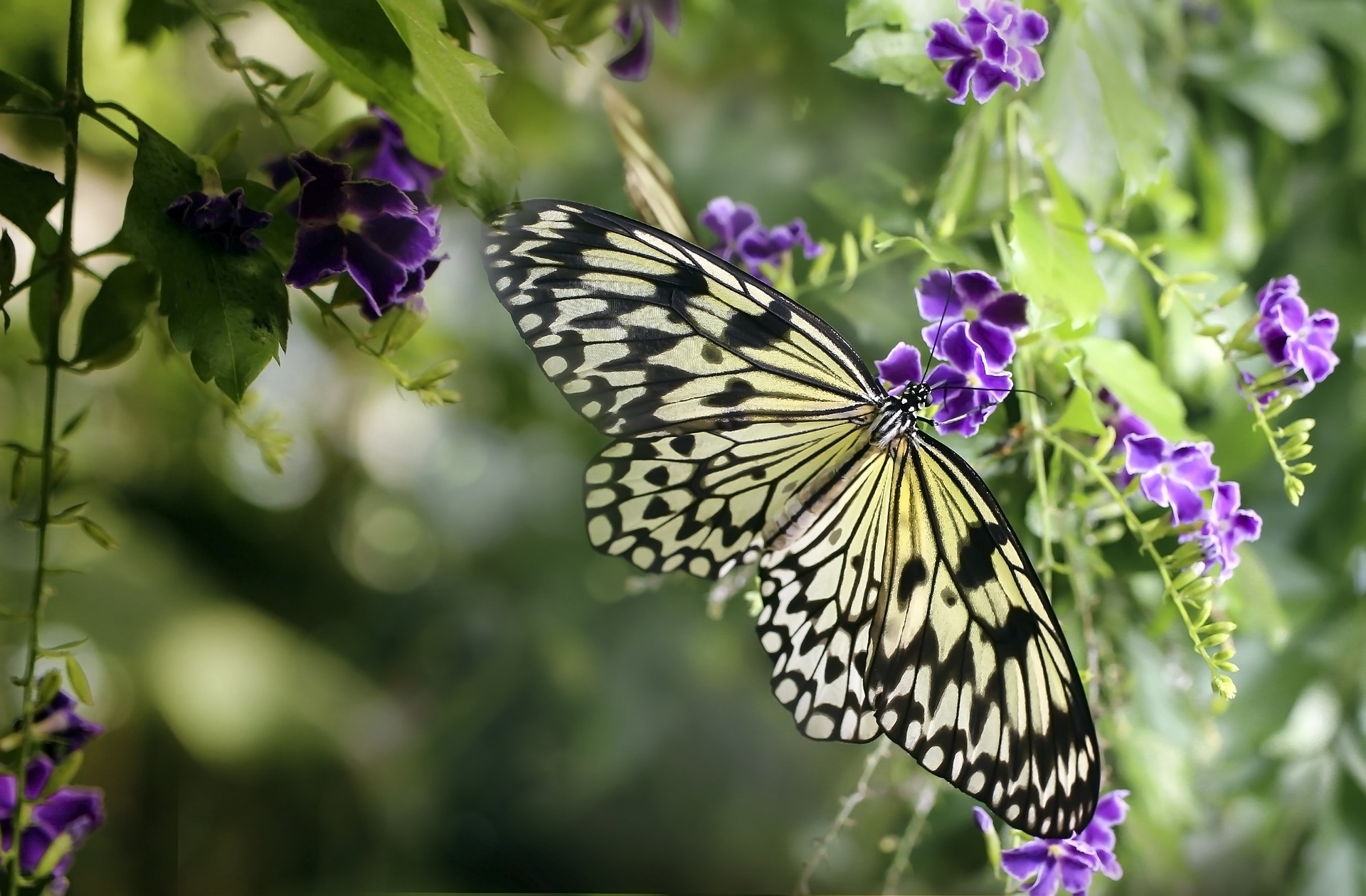
With its glorious sprays of deep purple flowers that dangle in graceful sprays, Duranta erecta brings vivid tropical color to any Gulf Coast area garden. Native to the tropical regions of the Americas, the most used Duranta erecta common name is Golden Dewdrop, though some call it Pigeon Berry. It boasts vibrant color and an elegant weeping shape, blooming profusely and attracting bees and butterflies.
Duranta erecta is a multi-stemmed shrub that can reach a height of 6 to 15 feet with a spread of 6 to 10 feet. It features an upright and bushy growth habit, adorned with glossy green foliage and clusters of vibrant flowers.
The foliage of the Duranta erecta plant consists of small, elliptical leaves arranged in an opposite or whorled pattern along the stems. The leaves have a lustrous green color and provide an attractive backdrop to the blossoms. The plant is evergreen in subtropical and tropical climates.
One of the highlights of Duranta is its showy flowers. The pendulous flower clusters, known as racemes, dangle from the branches and are adorned with tubular blossoms. The flowers come in various colors, including shades of purple, blue, white, or a combination of these hues, creating a striking visual display.
Duranta Origins
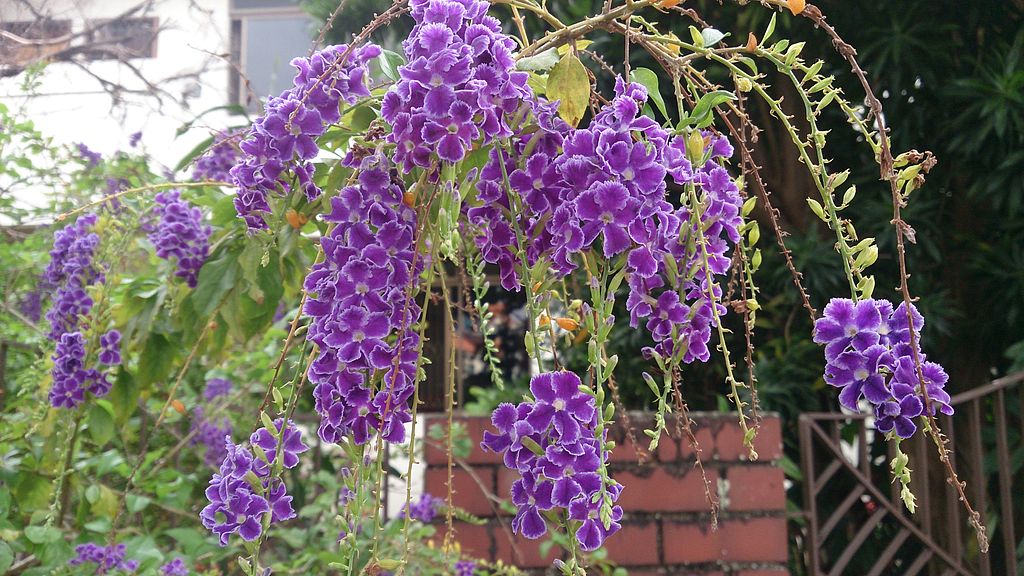
Duranta erecta originates from the Caribbean, Mexico, and South America, where it thrives in warm and tropical climates. It has since become naturalized in many parts of the world, including the Gulf Coast region of the United States.
In its native habitat, you’ll find Duranta growing in open woodlands, thickets, and disturbed areas. It is well-adapted to tropical and subtropical environments, showcasing its resilience and versatility.
Duranta is generally suitable for growing in USDA hardiness zones 9 to 11. Growing Duranta in Florida provides a particularly favorable climate for the successful cultivation of this tropical beauty. It also thrives along the Gulf Coast in Texas and Louisiana.
Optimal Growing Conditions
Duranta erecta thrives in full sun to partial shade, making it adaptable to different light conditions. It prefers well-draining soil with moderate moisture retention. Once established, it can tolerate periods of drought.
Golden Dewdrop Duranta erecta delivers a prolonged flowering season, typically spanning from spring to late fall. During this time, the plant produces an abundance of blossoms, drawing in squadrons of delighted bees.
Duranta berries are small, spherical fruits that develop after the flowering period. They are a vibrant golden or yellow color, hence the common name for Duranta: “Golden Dewdrop.”
These berries, typically about 1/2 inch in diameter, add ornamental value to the plant and contribute to its overall visual appeal. However, it is important to note that the berries are considered toxic if ingested, especially to children and pets, so precautions should be taken to prevent accidental ingestion.
Wildlife Benefits of Golden Dewdrop Duranta Erecta
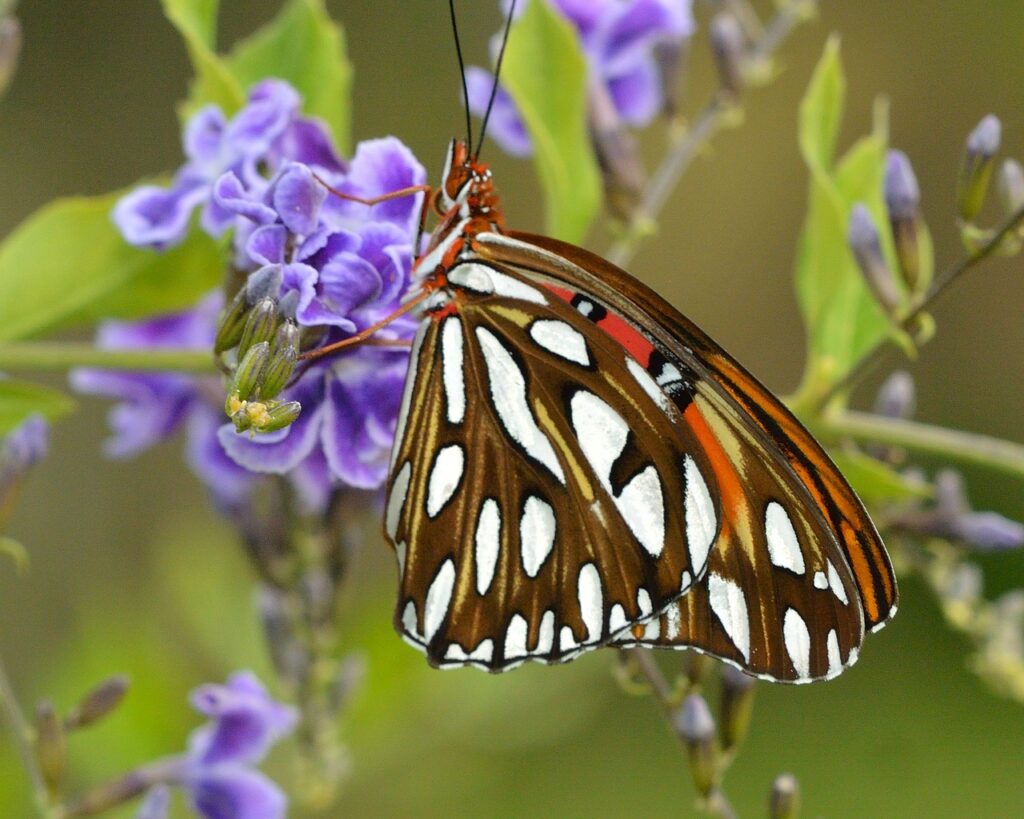
Duranta erecta serves as a valuable host plant for butterfly species such as the Gulf Fritillary (Agraulis vanillae) and the White Peacock (Anartia jatrophae). These butterflies lay their eggs on the leaves, and the resulting larvae, or caterpillars, feed on the foliage.
Duranta Erecta Care
Care of your Golden Dewdrop plant is relatively straightforward when grown under the right conditions.
Light Requirements
Duranta erecta thrives in full sun to partial shade. It prefers a minimum of 6 hours of direct sunlight per day for optimal growth and flowering. In areas with intense afternoon sun, providing partial shade during the hottest part of the day can help prevent stress and sunburn.
Soil Type
Duranta prefers well-draining soil that retains some moisture without becoming waterlogged. It adapts well to various soil types, including loam, sandy, or clay soils.
Soil pH
The ideal soil pH for Duranta ranges between slightly acidic to slightly alkaline, around 6.0 to 7.5. Conduct a soil test to determine the pH level and amend the soil if necessary to maintain the desired range.
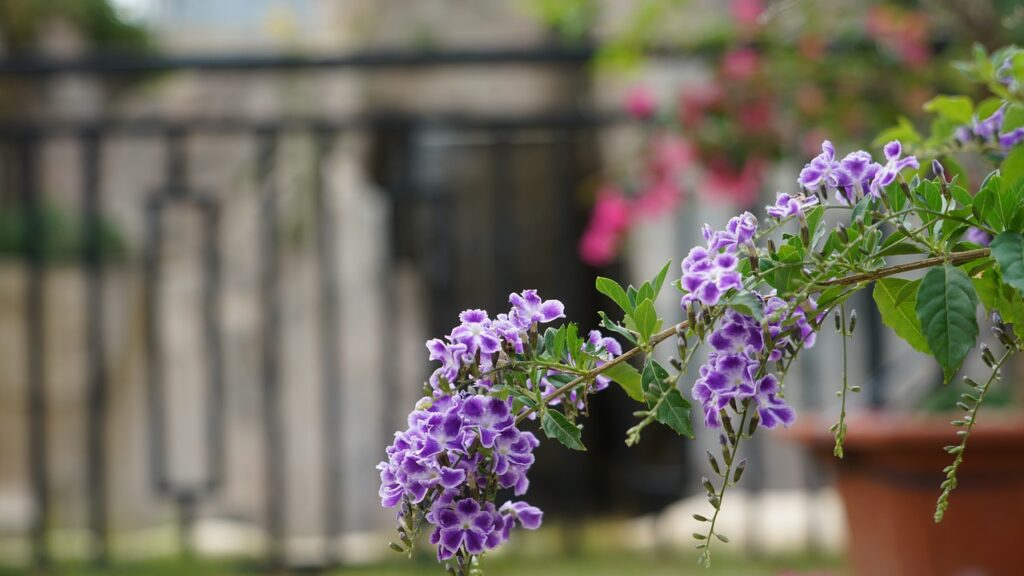
Climate Requirements
Golden Dewdrop is well-suited to tropical and subtropical climates. It thrives in areas with warm temperatures, moderate humidity, and mild winters.
Temperature Tolerances
The optimal temperature range for Duranta is between 65°F and 85°F, providing the ideal conditions for growth and flowering.
Duranta growth may slow or temporarily stop when temperatures drop below 50°F.
Prolonged exposure to temperatures below 32°F can cause damage and the plant may experience leaf drop, browning, or dieback of branches.
In extremely hot conditions above 95°F, Golden Dewdrop may experience heat stress, resulting in wilting, leaf burn, or reduced overall vigor. Providing shade or adequate watering can help mitigate the effects of high temperatures.
Protecting Duranta from Cold
When temperatures drop below freezing, protect Duranta from cold damage:
- Water well and deeply during the warmth of the day.
- Apply a layer of organic mulch around the base of the plant to insulate the roots and retain soil moisture.
- Cover the plant with a frost cloth or blanket during freezing temperatures to protect it from frost damage.
Elevation Concerns
Duranta is adaptable to various elevations within its suitable hardiness zones. However, keep in mind that colder temperatures at higher elevations may require additional protection during winter months.
Planting Duranta for Successful Establishment
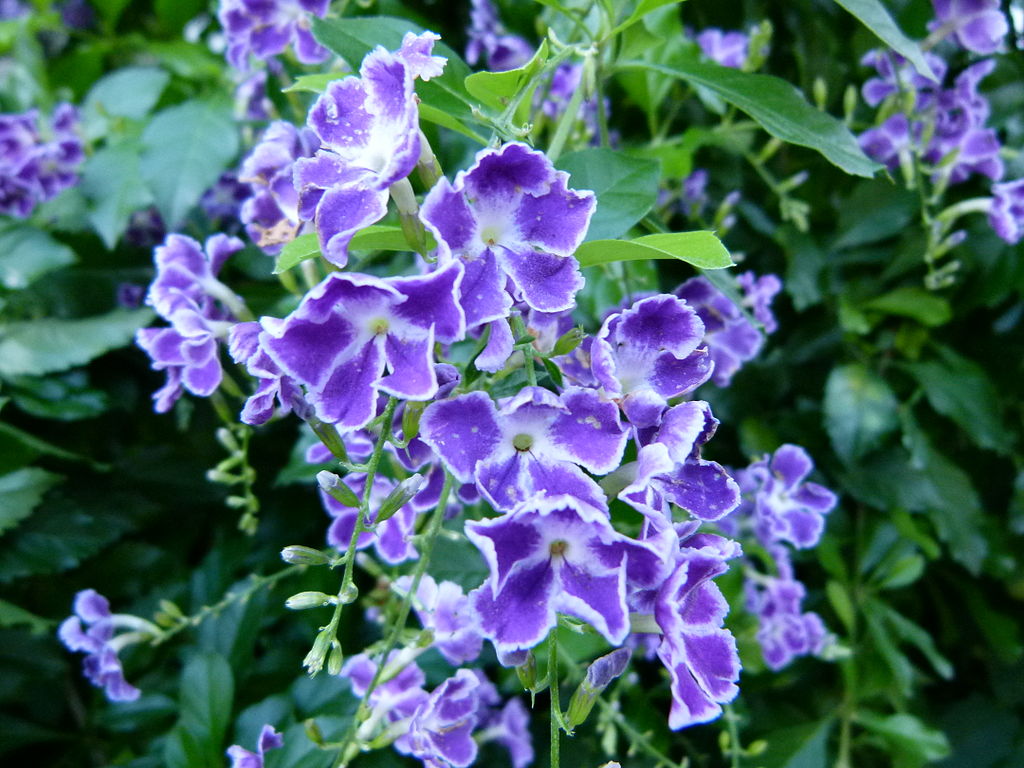
Considering your landscape carefully before planting your Duranta. Remember, it will grow to a large size if not regularly pruned.
Choosing a Location
Select a site that receives full sun to partial shade, ensuring at least 6 hours of direct sunlight per day.
Consider the plant’s mature size and provide enough space for it to grow without overcrowding nearby plants or structures.
Ensure the planting location has well-draining soil to prevent waterlogging.
Step-by-Step Instructions for Planting a Duranta erecta Plant:
Dig a hole: Dig a hole that is twice the width and slightly deeper than the root ball of the Duranta erecta plant.
Prepare the soil
If the soil is heavy clay or lacks organic matter, mix in compost or well-rotted manure to improve drainage and fertility.
Remove the plant from its container
Gently tap or squeeze the container to loosen the root ball, then carefully slide the plant out.
Position the plant
Place the plant in the center of the hole, ensuring that the top of the root ball is level with or slightly above the soil surface.
Backfill the hole
Fill the hole with the amended soil, gently firming it around the root ball to eliminate air pockets.
Water thoroughly
Give the newly planted Duranta erecta a deep watering to settle the soil and establish good root-to-soil contact.
Aftercare
Provide regular watering, keeping the soil consistently moist but not waterlogged, especially during the first few months after planting.
Apply a layer of organic mulch around the base of the plant, keeping it a few inches away from the stem. Mulch helps conserve soil moisture and suppress weeds.
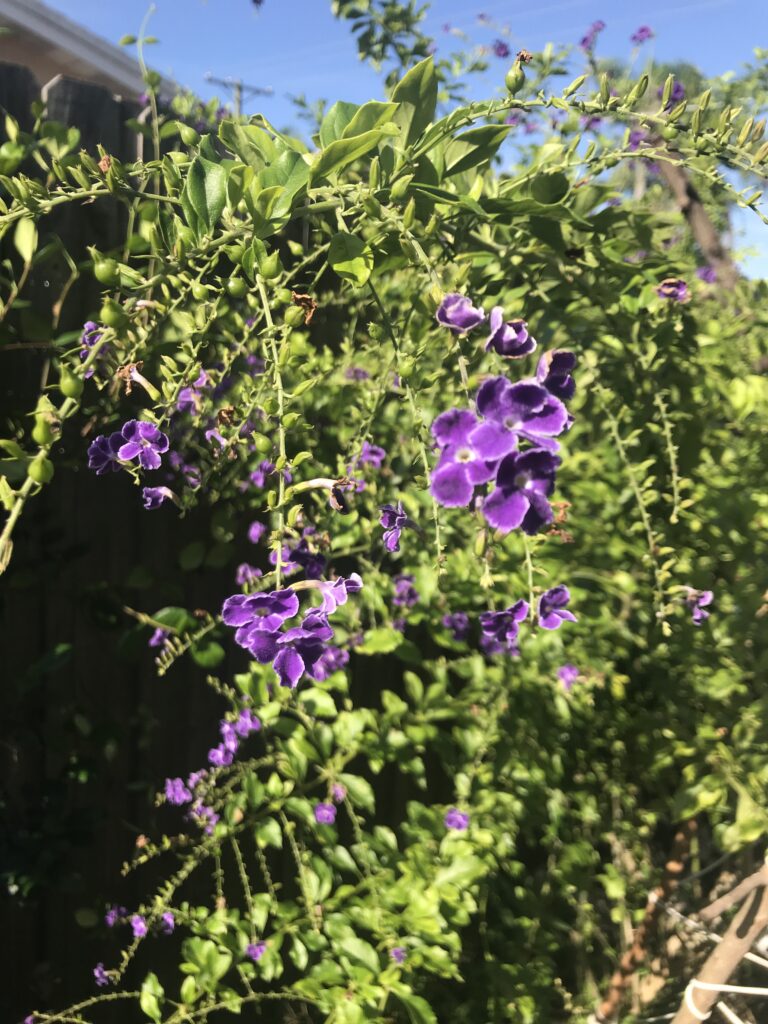
Watering Schedule
Duranta can be a thirsty plant, so consider the weather and temperature when deciding how frequently to water your plant.
- Spring: Water thoroughly and regularly as new growth emerges.
- Summer: Increase watering during hot and dry periods to ensure adequate soil moisture.
- Fall: Maintain regular watering as the plant prepares for winter.
- Winter: Reduce watering, allowing the soil to dry out slightly between waterings.
Optimal Duranta Fertilizer Composition and Schedule
To make the most of your fertilizer dollars, make sure you feed your Golden Dewdrop appropriately throughout the year.
Leafing Out (Spring)
Use a balanced slow-release fertilizer, such as a 10-10-10 or 14-14-14. Apply according to the package instructions, typically in early spring when new growth begins. Follow recommended rates based on the size and age of the plant.
Blossom (Summer)
Switch to a fertilizer higher in phosphorus, such as a 10-20-10 or 15-30-15. Apply as directed on the package during the active blooming period to support flower production and quality.
Pre-Winter/Over Winter
Avoid fertilizing during late fall and winter when the plant enters a period of dormancy. Instead, focus on providing adequate moisture and protecting the plant from cold temperatures.
Placing a thick layer of compost or other organic matter under the mulch to break down over winter will provide better growing conditions in spring.
Note: It is crucial to follow the specific instructions provided by the fertilizer manufacturer and adjust the amounts based on the plant’s needs and growing conditions.
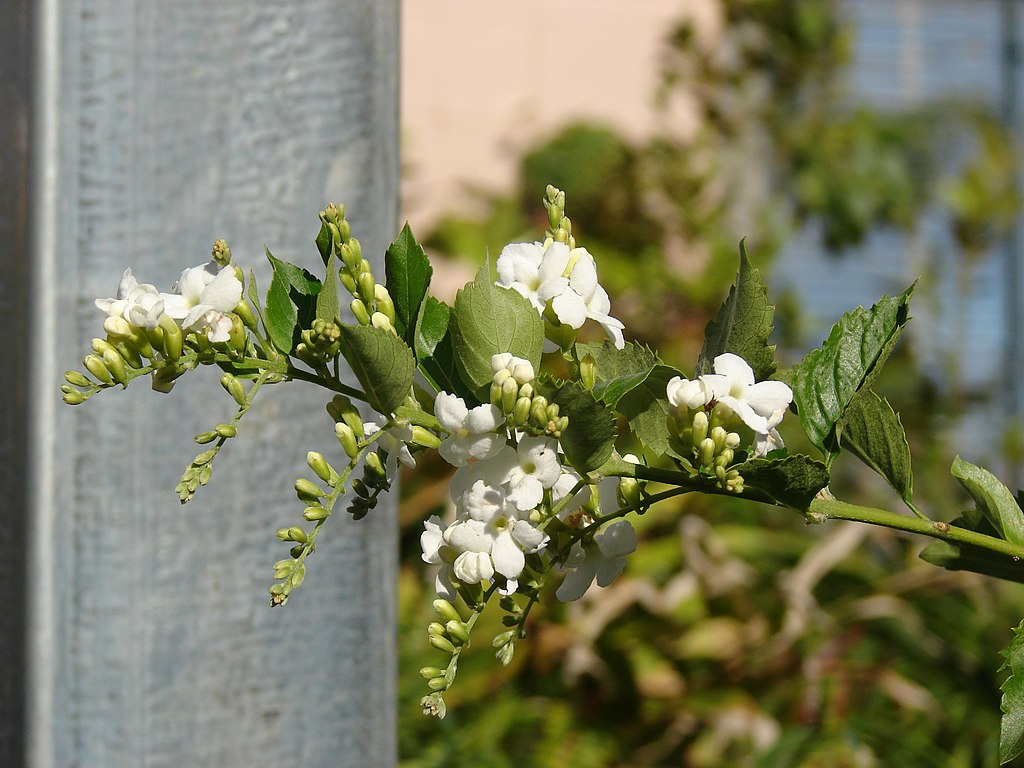
Common Duranta Pests
There are a few pests that might make a meal of your Golden Dewdrop. Remember that you don’t have to remove them if you choose not to. Many of these pests provide food for wildlife, so you may want to refrain from treatment unless they threaten the life of your plant.
Aphids
These small, soft-bodied insects cluster on new growth, sucking sap from the plant. Use a strong jet of water to dislodge them and let ladybugs feast on the rest.
It’s also a good idea to look for ants if you see an aphid infestation. Ants will protect aphids from predators in order to farm them for their “dew.”. An ant trap with boric acid will reduce the number of ants and aphids in an environmentally friendly way.
Whiteflies
These tiny, white insects congregate on the undersides of leaves, causing yellowing and stunted growth. Remedy: Use insecticidal soap, neem oil, or introduce natural predators like ladybugs or lacewings.
Caterpillars
Various caterpillar species, such as the caterpillars of the Gulf Fritillary butterfly, can feed on the leaves. We recommend handpicking them, but only if they seem to be a real threat to your Duranta erecta plant.
Note that Oleander moth caterpillars may also infest your Duranta plant and become devastating. Unfortunately, it is easy to confuse them with Gulf Fritillary caterpillars.
Spider Mites
These tiny pests cause yellow stippling on leaves and produce fine webbing. Spray the foliage with a strong jet of water to dislodge them or apply insecticidal soap or horticultural oil. Spider mites usually appear only on dry and desiccated plants, so spray the plant frequently and water more regularly.
Golden Dewdrop Common Diseases
Leaf Spot: Fungal leaf spot diseases can cause dark spots or patches on the leaves. Prune infected branches to improve air circulation around the plant. Fungicidal sprays may be necessary for severe infections. Copper sprays are generally considered safe and affordable and most are listed for organic gardening.
Powdery Mildew
This fungal disease forms a white, powdery coating on the leaves, stems, and flowers. Prune to Improve air circulation, avoid overhead watering, and apply fungicidal sprays as needed.
A solution of 8-12 tablespoons of household hydrogen peroxide (3%) in 1 gallon of water sprayed every three days for a week will reduce powdery mildew with diligent application.
Root Rot
Overwatering or poorly drained soil can lead to root rot, causing yellowing leaves, wilting, and eventual plant decline. Remedy: Ensure proper drainage and adjust watering practices. If unable to remediate the soil quality, you may need to move the plant to a location with better drainage.
Duranta Eerecta Propagation
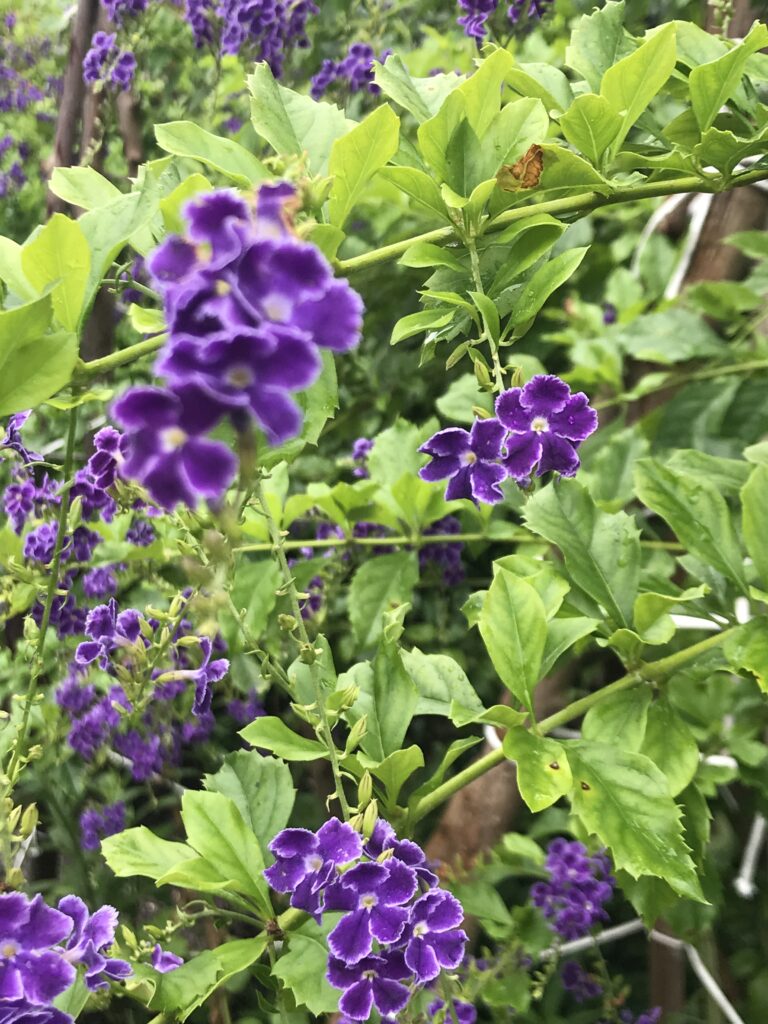
Although it may take several tries and some time to propagate Duranta from cuttings, it’s well worth your effort.
- Select a stem cutting: Choose a healthy, non-flowering stem measuring about 4 to 6 inches (10 to 15 cm) in length.
- Prepare the cutting: Use clean, sharp pruning shears to make a clean cut just below a leaf node.
- Remove lower leaves: Remove the lower leaves, leaving a few leaves at the top of the cutting.
- Apply rooting hormone (optional): Dip the cut end of the cutting into a rooting hormone powder or gel to enhance root formation.
- Plant the cutting: Insert the cut end of the stem into a well-draining potting mix or a mix of peat moss and perlite, ensuring at least one node is below the soil surface. I use a 50/50 mix of coco coir and perlite that provides both moisture retention and excellent drainage.
- Provide optimal conditions: Place the potted cutting in a warm, bright location with indirect sunlight. Maintain a consistently moist but not waterlogged soil.
- Rooting process: Keep the soil moist and provide high humidity by covering the cutting with a plastic bag or using a propagation tray with a clear lid. Roots should develop in a few weeks to a few months.
- Transplanting: Once the roots have developed, carefully transplant the rooted cutting into a larger pot or desired planting location.
Landscaping with Duranta
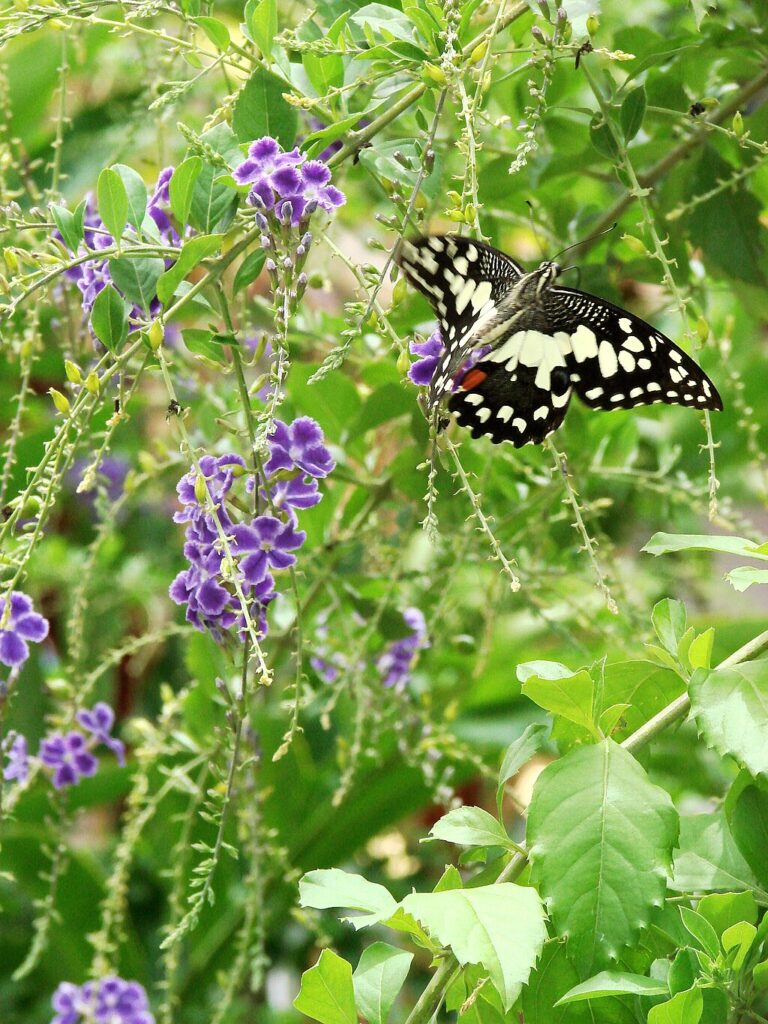
Golden Dewdrop’s striking appearance and adaptability make it a valuable addition to various landscaping designs.
One of the benefits is that you can prune Duranta erecta into a tree shape. You can also create a Duranta erecta hedge with a row of specimens.
Here are some other creative ideas to incorporate this versatile plant into your landscape:
Colorful Hedges and Borders
Use Duranta erecta as a hedge or border plant to create a vibrant living fence. Its dense foliage and colorful flowers add visual interest and define spaces. Consider planting them in a row along a pathway or around garden beds for a lively and eye-catching border. Prune regularly to ensure bushy growth and increase the density of the hedge.
Focal Point in Mixed Borders
Plant Duranta as a focal point within mixed borders or perennial beds. Its tall stature and profusion of blooms draw the eye and provide a stunning centerpiece. Combine it with other flowering plants that complement its colors, such as salvias, lantanas, or petunias.
Container Gardening
Duranta is well-suited for container gardening. Place potted specimens on patios, balconies, or porches to add a tropical touch to your outdoor living spaces. Choose large containers to accommodate the plant’s mature size and pair it with cascading or trailing plants for added texture and visual interest.
Poolside Landscaping
The lush foliage and attractive flowers of Duranta erecta make it an excellent choice for poolside landscaping. Plant it as a backdrop to create a tropical oasis around your pool area. The reflection of the blooms on the water’s surface adds a touch of tranquility.
Butterfly and Pollinator Gardens
Duranta’s nectar-rich flowers attract butterflies, bees, and other pollinators. Create a dedicated butterfly or pollinator garden by incorporating Golden Dewdrop along with other butterfly-friendly plants, such as milkweed, butterfly bush, and zinnias. This will not only enhance the visual appeal but also contribute to the local ecosystem.
Landscape Ornamentals that Pair Well with Duranta
When choosing companion plants for Duranta, consider those with similar soil, light exposure, water, and fertilization requirements. Here are a few examples:
Native Lantana (Lantana depressa)
These colorful flowering perennials share similar growth habits and requirements with Duranta. Their vibrant yellow blooms complement the deep purple of Duranta and attract pollinators.
Pentas (Pentas lanceolata)
With their long-lasting clusters of star-shaped flowers, Pentas create a beautiful contrast when planted alongside Golden Dewdrop. They thrive in similar conditions and provide additional pops of color.
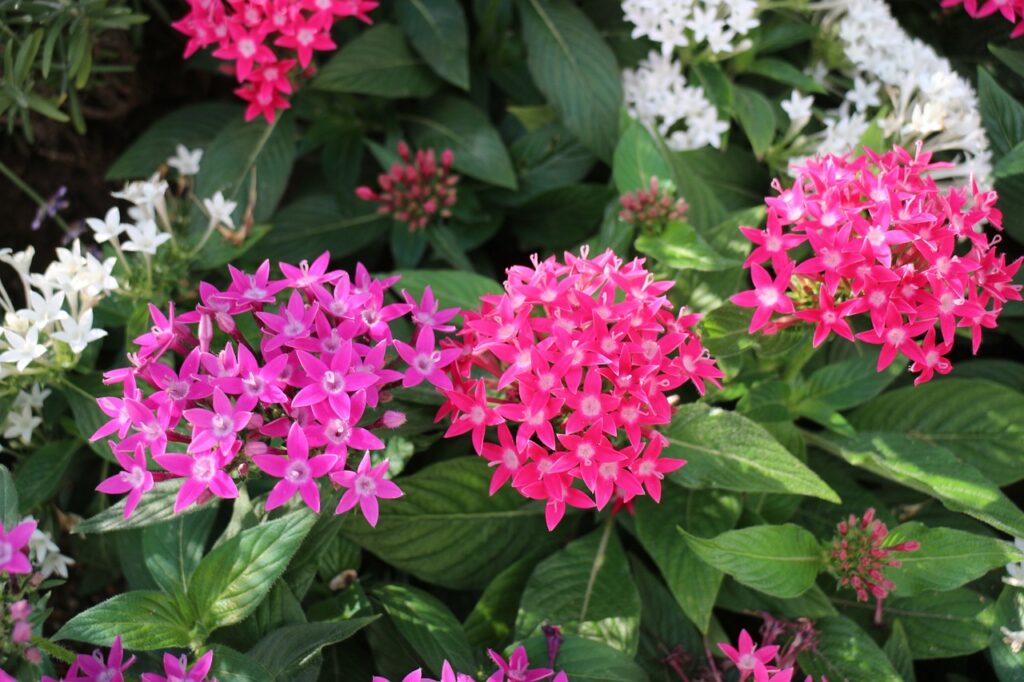
Tropical Sage (Salvia coccinea)
The upright, red flower spikes of Tropical Sage create an excellent complement to Duranta’s vivid purple blooms.
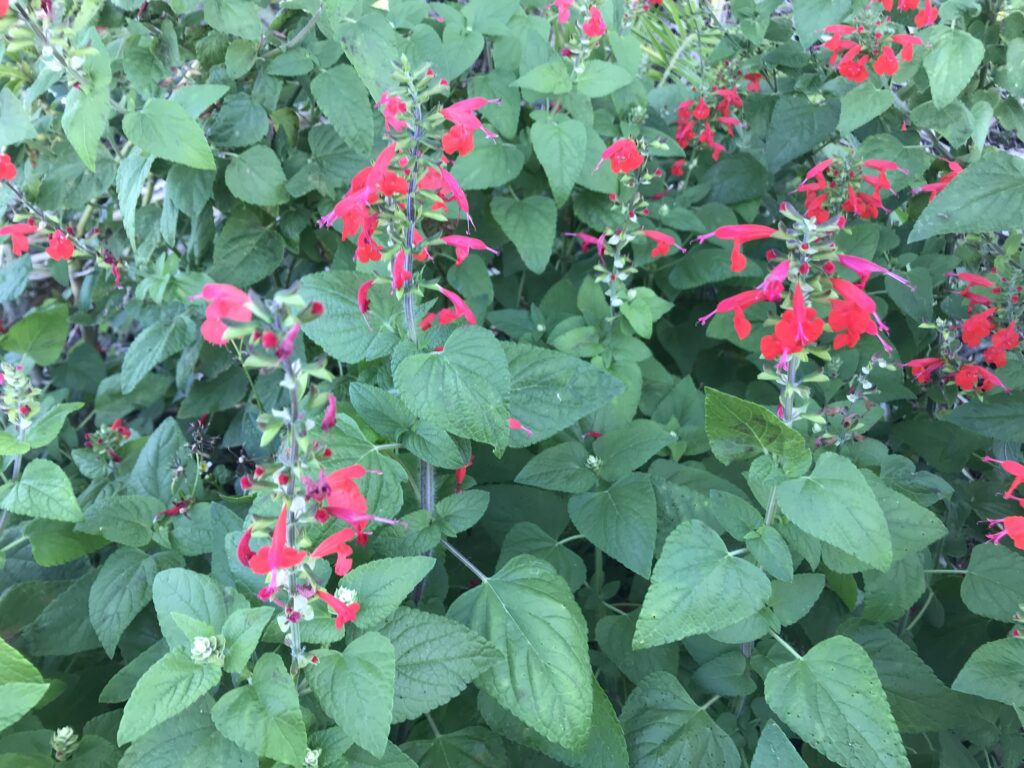
Plumbago (Plumbago auriculata)
The delicate blue flowers of Plumbago complement the colors of Golden Dewdrop and both plants thrive in similar conditions.
Cape Honeysuckle (Tecomaria capensis)
This evergreen shrub displays clusters of vibrant orange or red tubular flowers, creating a stunning contrast when planted alongside Duranta.
Firebush (Hamelia patens)
With its fiery red-orange tubular flowers, Firebush adds a splash of color and attracts hummingbirds, making it an excellent companion plant.
Society Garlic (Tulbaghia violacea)
This perennial herb features attractive gray-green foliage and clusters of purple flowers. It pairs well with Duranta erecta and adds a delightful fragrance to the garden.
Mexican Flame Vine (Senecio confusus)
Known for its bright orange blooms, Mexican Flame Vine creates a beautiful backdrop when combined with Duranta.
Coral Honeysuckle (Lonicera sempervirens)
This native Florida vining plant that produces attractive red-orange tubular flowers, which can create a beautiful contrast when planted near Duranta colorful blooms. Additionally, Coral Honeysuckle is known to attract hummingbirds, further enhancing your garden’s appeal to wildlife.
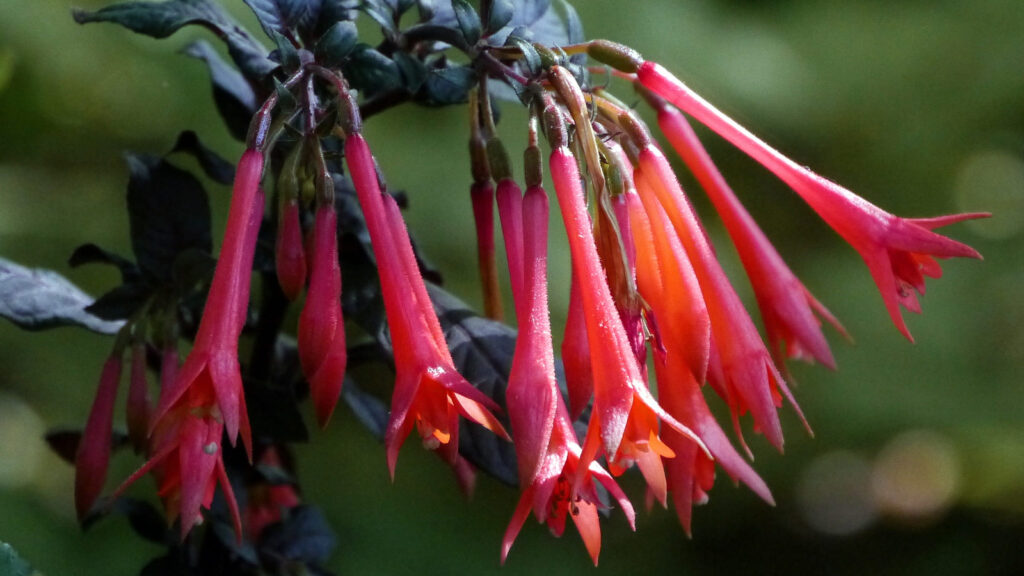
These plant selections will provide a diverse landscape, attracting pollinators, beneficials, and other wildlife to your subtropical garden.
Vivid Gulf Coast Garden Color
Duranta erecta, with its vibrant purple flowers, bright golden berries, and attractive foliage offers numerous opportunities for tropical landscaping designs. Planted with native Gulf Coast region flowering perennials and other wildflowers, your garden will soon be bursting with life, movement, and color.
FAQ – Frequently Asked Questions About Growing Duranta
Can Duranta take full sun?
Yes, Duranta erecta thrives in full sun but can also tolerate partial shade.
Is a Duranta a perennial?
Yes, Duranta erecta is a perennial shrub.
Will Duranta survive a freeze?
Duranta is sensitive to freezing temperatures and may experience damage or die back in severe freezes.
Does Duranta erecta like sun or shade?
Duranta prefers full sun to partial shade.
How cold can Duranta tolerate?
Duranta can tolerate temperatures down to around 25°F (-4°C), but extended cold periods can cause damage or even kill the plant.
Do hummingbirds like Duranta?
Yes, hummingbirds are attracted to the vibrant flowers of Duranta erecta.
What hardiness zone is Duranta erecta?
Duranta erecta is typically suitable for USDA hardiness zones 9 to 11.
Should I deadhead Duranta?
Deadheading spent flowers can encourage continued blooming and maintain a neat appearance, but it is not necessary. You may want to trim off and dispose of the berries if you have concerns about their toxicity.
How big does Duranta get?
Duranta erecta can grow to a height of 6 to 15 feet (1.8 to 4.6 meters) with a spread of 6 to 10 feet (1.8 to 3 meters).
Does Duranta bloom all summer?
Duranta erecta has a prolonged flowering season, typically blooming from spring to fall, but the intensity and duration of flowering can vary.
Is a Duranta a tree or a bush?
Duranta erecta is typically grown as a bushy shrub, but it can be trained into a small duranta erecta tree form with proper pruning.
How do you take care of Duranta in the winter?
In winter, protect Duranta erecta from frost by covering it with a frost cloth or blanket and applying a layer of organic mulch around the base to insulate the roots.
Does Duranta attract bees?
Duranta erecta does attract bees and butterflies with its nectar-rich flowers.
What is the common name for Duranta?
Duranta erecta is commonly known as Golden Dewdrop or Pigeon Berry.
Does Duranta erecta have medicinal uses?
While Duranta erecta has some traditional medicinal uses, it is primarily cultivated as an ornamental plant. In certain cultures, various parts of Duranta erecta, such as the leaves and roots, have been used in traditional medicine to treat conditions like fever, cough, respiratory ailments, and skin infections.
What is Duranta erecta aurea?
Duranta erecta aurea is a cultivar of Duranta erecta with golden or yellow foliage.
What is Duranta erecta alba?
Duranta erecta alba is a cultivar of Duranta erecta with white flowers.
Where can I purchase Duranta erecta?
We frequently carry Duranta in our nursery. You can check out our Etsy shop for the current inventory.



